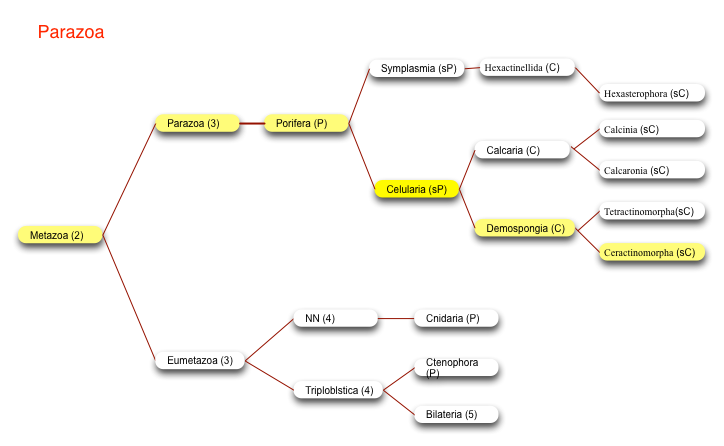
- Subphylum Cellularia
- Class Demospongiae: Demosponges (Figures 1B, C, and F). With siliceous spicules; spicule skeleton may be supplemented or re placed by an organic collagenous network ("spongin"); marine, brackish, or freshwater sponges, occurring at all depths. Sub class homoscleromorpha: Embryos incubated, larvae amphiblastulae; differentiation of spicules into mega‑ and microscleres not evident; all spicules very small (usually less than 100 um) and distributed in large numbers t
- Subclass Ceractinomorpha: Mostly viviparous, with incubation of parenchymula larvae; distinct microscleres and megaslceres present; spongin present in all but one family (Halisarcidae); includes the freshwater families Spongillidae and Potamelepidae( e.g., Adocia, Splysilla, Axociella, Callyspongia, Clathria, Coelosphaera, Ephydatia, Eurspongia, Halichondria*, Haliclona*, Halisarca, Halispongia, Hymeniacidon, Ircinia, Lissodendoryx, Microciona*, Mycale, Myxilla, Neofibularia, Siphonodictyon*, Spongia, Spongillla*, Tedania, Verongia). The Ceractinomorpha is now judged to include some sponges previously assigned to the Sclerospongiae. These include the stromatoporids (e.g. Astrosclera, Subclass Amphidiscophora: Body never attached to a hard substra tum but anchored in soft sediments by a basal tuft or tufts of spicules; megascleres discrete spicules, never fused into a rigid network; microscleres never hexasters; mostly deep‑water. Calcifibrospongia), and the ceratoporellids (e.g., Ceratoporella, Stromatospongia, Hisidopetra, Goreauiella).
Click to view Images of living Demospongia
September 22, 2013

